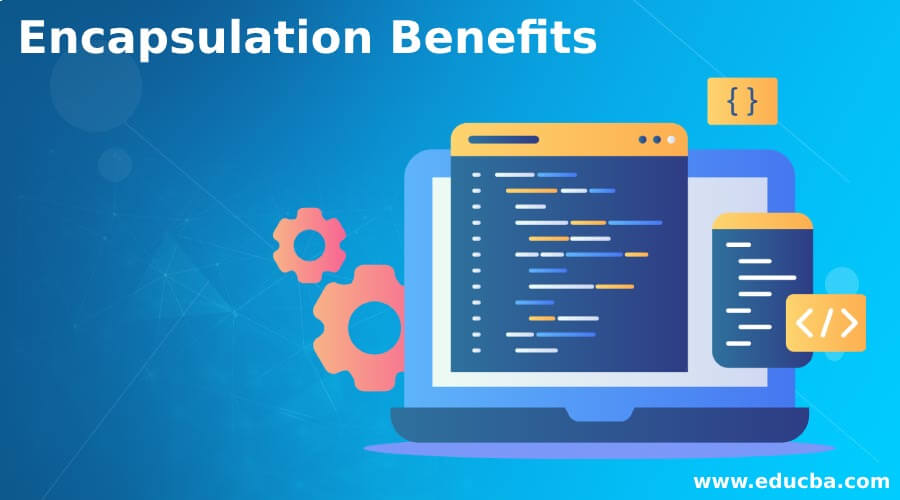Updated March 31, 2023
Introduction to Encapsulation Benefits
Basically, encapsulation is a method that combines the different elements into a single new entity to hide and protect the data. Normally encapsulation comes under the object-oriented programming languages that mean it is an attribute of object design. With the encapsulation, we provide security over the data and protect our data or, we can say, object from unwanted access by the user. In programming, human error may occur, so using encapsulation can reduce human error with the simple maintenance of software. C++, Java, and many more programming languages support the object-oriented language. In this topic, we will look at the Encapsulation Benefits.
Benefits of Encapsulation
Now let’s see what the benefits of encapsulation are in various programming languages as follows.
In C++, we can use encapsulation and hiding of data by using user-defined data types that we normally call class. Class is used to merge the information and function into a single entity, and the class contains the different members as follows.
- Public: In which all objects of the class are able to access the information or, we can say, data.
- Protected: This type of access is limited to some members of a class, or we can say that descendant.
- Private: In this type of member, access is limited means within a class or function.
- Internal: In which that access is limited.
- Protected Internal: In this type, access is limited for the current class.
So these are some parameters we use in encapsulation to now let’s see actual benefits of encapsulation.
The main benefit of encapsulation is that we can hide the information from the user. That means we provide security to our data or information by using the above member function. Furthermore, by using encapsulation, we can give access to a specified level without any complexity. Therefore, we can easily handle the application and understand the application.
By keeping information hidden, or we can say that it is private in programming language and offering public obvious assistance techniques, the part of the object turns out to be obvious to different objects. This builds ease of use. Different objects know about the configuration to send messages into the object by using the public service. This is basically an agreement between the two objects. The invoker is consenting to send the message in the particular structure, including passing any of the necessary boundary data. The conjured object is consenting to handle the message and, if essential, return worth in the predetermined structure.
By using encapsulation, we can create classes in different modes such as read-only and write-only mode. Another benefit of encapsulation is that we reduce human error because we write code in a proper manner and suitable.
Let’s consider a simple example of a washing machine; in this scenario, we just switch on the machine’s power button, and the machine gets started, and after some time, we switch off the power button of the machine, then the machine stops. The final conclusion of this scenario is that we don’t know what happens inside the washing machine or what type of mechanism is used. Notice here we see this is a very simple mechanism to wash the cloth just by pressing the power button, but inside the washing machine, a different element or we can say that object works together to wash the cloth. This mechanism is called encapsulation; see here, there is no complexity to handle the washing machine in a similar way. Therefore, when we use encapsulation in programming, it minimizes the complexity of the program, avoids human error, and protects the information.
We can easily change the encapsulated classes without changing the program according to the requirement. For example, let’s consider if some member we declared as private and we need to make it directly accessible from anywhere outside the class, so we just need to change the private keyword and write the public.
The shielding of the information implies that should the arrangement of the private information need to change for reasons unknown, the object summoning strategies on the object whose information has changed won’t have to change the configuration they send their messages in. For instance, in the event that we envision that we expected to change an information quality from float to double. (Both address genuine numbers; however, the twofold kind can regularly store bigger qualities.) On the other hand, if a customer object is refreshing the value straightforwardly, you will have to change the code in the customer object by changing the information type. On the off chance that you are managing enormous frameworks with many classes, this kind of circumstance can rapidly turn crazy with a few layers of “thump on” changes required. In this manner, we would say that exemplification advances upkeep since code changes can be made autonomously without affecting different classes.
When we talk about a java programming language, the encapsulation provides some different benefits as follows.
The Java programming language provides the setter and getter methods to make classes read-only and write-only. It also provides the control functionality over the data, which means we can provide the logic inside the method per our requirement.
Examples of Encapsulation Benefits
Now let’s see the example of encapsulation in C++ to better understand the benefits of encapsulation as follows.
Code:
#include<iostream>
using namespace std;
class Encapsulation_Benefits
{
private:
int y;
public:
void set(int b)
{
y =b;
}
int get()
{
return y;
}
};
int main()
{
Encapsulation_Benefits EB_obj;
EB_obj.set(7);
cout<<EB_obj.get();
return 0;
}
Explanation
By using the above program, we try to implement the encapsulation in C++. First, we create the class name as Encapsulation_Benefits after that, inside the class, we create a private member function with variable y. Then we set the value to that variable by using a public member function. Then we just call the class by using objects as shown in the above program. The final out of the above program we illustrate by using the following screenshot.
Conclusion
We hope from this article you learn the Encapsulation benefits. From the above article, we have learned the basic theory of Encapsulation, and we also see examples of Encapsulation. From this article, we learned the benefits of Encapsulation as well as how and when we use Encapsulation.
Recommended Articles
This is a guide to Encapsulation benefits. Here we discussed the basic theory of Encapsulation with its benefits along with the examples of Encapsulation. You may also look at the following articles to learn more –




